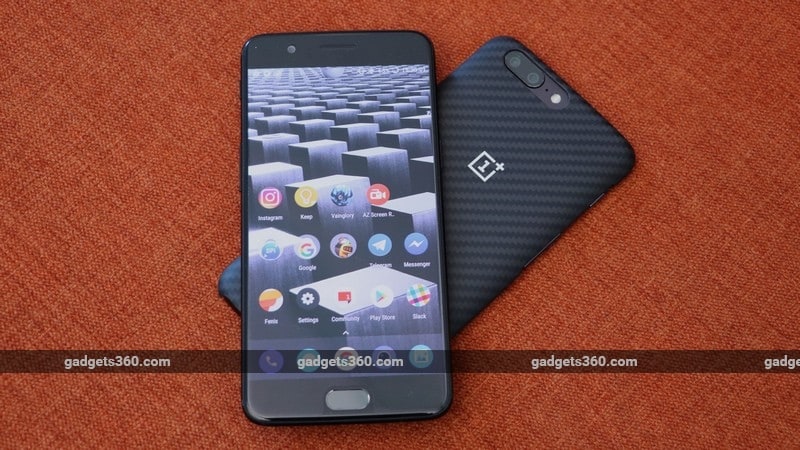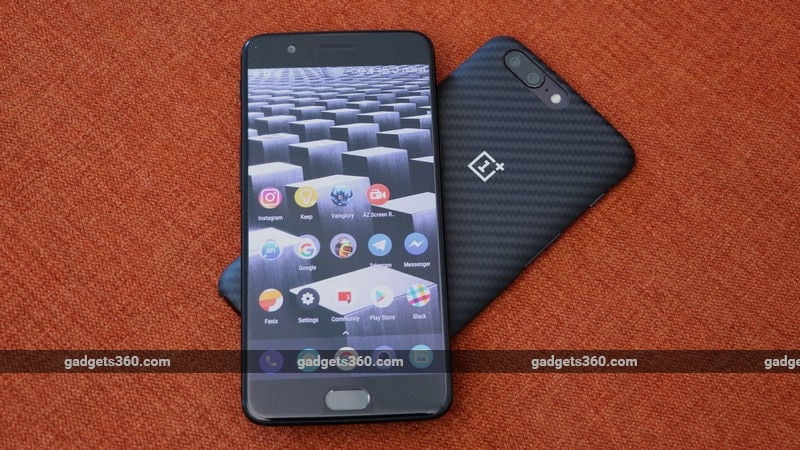
OnePlus has come a long way from its humble beginnings as a startup with its frustrating invite system to being one of the most sought-after enthusiast brands. All of its smartphones have stood for one thing – delivering leading specifications at aggressive prices, which is what has earned them the nickname “flagship killer”. With each generation so far this has proven true, and the OnePlus 3 was a big leap forward over its predecessor when it launched.
The company officially unveiled its 2017 model, the OnePlus 5 on Tuesday, and it has already been launched in India. The OnePlus hype machine has been doing a good job of keeping the buzz alive, and there is huge pressure on the company to deliver yet another standout product. The OnePlus 5 has already garnered massive response back on its home turf, and was also teased in the final match of a recently concluded cricket tournament last Sunday.
So, is the OnePlus 5 everything it’s made out to be? And can it also earn the title of ‘flagship killer’? We aim to answer these two burning questions in our OnePlus 5 review.
OnePlus 5 design and build quality
Now before we get started, we need to address the elephant in the room – design. From the front, this phone looks very similar to the OnePlus 3T (Review), but with more rounded corners and slight curves on the top and bottom. Given a fleeting glance, it would be hard to tell the two apart. The edges of the back have been shaved too, making the device more rounded overall. Antenna lines now wrap around the top and bottom of the rear to make space for the dual-camera module and LED flash. We have to admit, our first thought when we saw this was that it looks very much like an iPhone 7 Plus (Review), which is a common reaction because the style is definitely familiar.
This caused an uproar in our office, much like it did on the Internet when photos of the rear first leaked. Copying Apple’s designs is nothing new for many Chinese smartphone makers, but we guess most OnePlus fans expected something original. Once the initial surprise wears off, it’s not that big a deal. Build quality is still excellent thanks to the aluminium unibody, which is now slimmer at 7.25mm and lighter at 153 grams.

OnePlus has shaved off quite a bit of the side borders, and the glass curves along its edges, which makes the phone feel great when you hold it. It is a bit slippery without a cover as the sides are a lot thinner than on the OnePlus 3T, so that’s something to keep in mind. Luckily, the OnePlus 5 handles drops pretty well, and the couple of time we did accidentally drop it from waist height, we were left with only minor bumps and scuffs along the edges.
The 5.5-inch AMOLED panel really brings out deep blacks and rich colour saturation in content. Perhaps the best part here is that OnePlus has fixed the OnePlus 3T’s annoying touch latency issue. The display supports the DCI-P3 colour profile, which is also used by the iPhone 7. This offers a wider gamut compared to sRGB. The colour tone simply feels more natural and is much easier on the eyes. Sadly, OnePlus is sticking to full-HD as the screen resolution, which is one of the few compromises it had to make to keep the cost down – all other flagships are now pushing QHD or even 4K.

The screen tends to wash out pretty easily under direct sunlight. It’s worse if you use the ‘Dark’ theme, but even with the default appearance settings, things aren’t exactly great. The OnePlus 5 ships with a pre-applied screen protector, which we think is unnecessary due to the use of Gorilla Glass 5. The protector doesn’t cover the entire glass surface, so its edges rub against your fingers when you swipe from the sides of the phone, and lint accumulates at the edges.
In terms of physical connectors, we have a USB Type-C (USB 2.0 speed) port at the bottom along with a 3.5mm headphones socket and a speaker grille. Button placement remains the same as on previous models, with the power button on the left and the volume rocker plus an Alert Slider on the right. The Dual-SIM tray accepts two Nano-SIMs, and 4G is supported with VoLTE.

The OnePlus 5 does pack some new aesthetic touches such as the bevelled edges of the speaker grille and USB port being painted black. However, the paint around the camera bump on our Space Gray unit started chipping after just a day’s usage. When we questioned OnePlus, it told us that this was an isolated incident with our review unit since it was from an early batch. The Midnight Black unit we received didn’t get damaged as easily, and although it wasn’t as apparent, we did notice that small portions of the finish had faded after a week of usage.
In the box, you get a USB Type-C cable and a pretty chunky power adapter, which is the same as the one we got with the OnePlus 3T Midnight Black Edition. There aren’t any headphones or a cover bundled in the box. Overall, the OnePlus 5 feels a lot more ergonomic and comfortable to use than its predecessor due to its slimmer and lighter body. This phone is best used with a cover to avoid accidental slips (and possibly prevent undesired paint chipping around the camera bump). Between the two colour options, we think that black will be more popular.
OnePlus 5 specifications and features
OnePlus earned its reputation to begin with by offering top-end specifications, and the company hasn’t skimped here at all. The SoC of choice is Qualcomm’s Snapdragon 835, which has eight CPU cores capable of running at up to 2.45GHz. There are two variants, Slate Gray with 6GB of RAM and 64GB of storage, and Midnight Black with 8GB of RAM and 128GB of storage. OnePlus is also making a big deal about the type of RAM and storage it has used for the OnePlus 5 – LPDDR4X and UFS 2.1 respectively, with a two-lane ROM which is said to double bandwidth for faster app install speeds and loading times.
In benchmarks, the OnePlus 5 put on a very good show compared to its peers, although it’s best to take these number with a pinch of salt if you go by XDA Developers’ report of how the OnePlus 5 potentially manipulates benchmarks for higher numbers. We initially ran tests that didn’t require an Internet connection and also compared results to the scores we got after the Oxygen 4.5.1 update, which rolled out right after the global keynote. The scores did dip a little when compared to our earlier readings, which shows that OnePlus might have corrected whatever was going on with the original firmware. However, the Random Write test on the 128GB version of the 3T still trumps everyone else.
| OnePlus 5 (6GB) | OnePlus 5 (8GB) | OnePlus 3T | Samsung Galaxy S8+ | |
|---|---|---|---|---|
| AnTuTu | 180,748 | 180,929 | 159,242 | 171,342 |
| PCMark (Work2.0) | 6,761 | 6,662 | 6,123 | 5,202 |
| 3DMark (Slingshot Extreme) |
3,238 | 3,115 | 2,623 | 3,315 |
| Geekbench | ||||
| Single | 1,972 | 1,951 | 1,878 | 1,997 |
| Multi | 6,696 | 6,676 | 4,471 | 6,712 |
| Androbench (MB/s) | ||||
| Sequential Read |
744 | 738 | 406 | 792 |
| Sequential Write | 193 | 222 | 164 | 204 |
| Random Read | 140 | 138 | 128 | 125 |
| Random Write | 18.9 | 24 | 72 | 15 |
Note: Benchmarks were run on OxygenOS 4.5.1 for the OnePlus 5.
Other specifications include NFC, Bluetooth 5.0 with aptX and aptX HD support, dual-band Wi-Fi a/b/g/n/ac with 2×2 MIMO antennas, GPS, and USB-OTG. The fingerprint sensor is integrated into the home button. It’s very quick at authentication and we rarely ever had a misread. You can use it to access locked apps and your Secure Folder in the File Manager app. You also get the usual suite of sensors along with a gyroscope. Certain features like FM radio and wireless charging are missing.
Apart from the OnePlus 5’s brand new hardware, another big change is the slick new OxygenOS 4.5.0. It’s built on Android 7.1.1 Nougat and feels a bit more refined than before, with slightly smaller icons and text for the menus. There’s no app drawer button now as you simply swipe up to expand the dock, à la the Google Pixel. Swiping right takes you to Shelf, which lets you customise widgets for the weather, set reminders, see your recent apps, and monitor cellular data and storage usage. This can be disabled if needed. Long-pressing the icons of compatible apps brings up Nougat’s shortcuts to commonly used features.
The Settings app is where you’ll find most of the OnePlus 5’s customisations. You can change the behaviour of the Alert Slider for its three settings – Ring, DnD and Silent. However, you still cannot set DnD to kick in automatically at a designated time. Doing this manually a huge chore, but it’s something you have to get used to. The functions of the capacitive buttons can be swapped if needed, and you can enable on-screen buttons too. You can also assign functions to long- and double-presses of the Home and capacitive keys as per your needs. Screen gestures include a double-tap to wake, three-finger screenshot capture, and the ability to launch apps or a function by tracing letter shapes when the screen is of.

OxygenOS also has other cool features like Reading Mode, which turns the display monochrome, making it easier to read text. It also goes a step further and adjusts the white balance to the ambient light around you, so depending on the light, you’ll have anything from a pale white to pale yellow. You can select which apps need to run in Reading Mode, so it kicks in automatically when you launch them, or you can manually engage it for the entire OS. Expanded Screenshots essentially let you take scrolling screenshots of webpages; Night Mode can now be engaged automatically based on time; there are five vibration patterns for incoming calls; and Gaming DnD mode lets you disable the capacitive buttons and block notifications in apps of your choosing.
For the Indian market, OnePlus has added a shortcut to launch the Paytm app by simply long-pressing the Home button. It works with the screen off as well as on. This doesn’t actually let you make a payment via Paytm, but simply launches the app’s QR code scanning page. Currently, only Paytm is supported. In terms of pre-installed apps, you get Amazon’s shopping, Prime Video and Kindle apps since this is Amazon exclusive, as well as Google’s suite of apps and a OnePlus Community app which lets you keep track of announcements and participate in the OnePlus forum.
OnePlus 5 performance, camera, and battery life
With Qualcomm’s speedy processor and the slick new OxygenOS, system and app performance is excellent. The phone uses the ample RAM onboard to ensure things run smoothly. On average, we found around 3.9GB being used, leaving us with about 1.7GB on the 6GB model. Flicking through the apps in the app drawer and switching between them doesn’t put any stress on the phone, and the transitions are buttery smooth – dare we say Pixel-smooth. Call quality is very good and we never faced any audio issues during a call. The speaker is also pretty loud for conference calls.The ambient light sensor can be a bit too aggressive in low light, and we needed to override it manually at times to make the display brighter.

The OnePLus 5 excels at gaming and media playback. We went through extensive sessions of Asphalt 8 and GTA: Vice City and the phone easily held its own. We noticed a few dropped frames in Asphalt 8 in some levels but other than this, we had smooth framerates throughout. The best part is that the phone doesn’t overheat even when we used outdoors in our humid climate. The back gets a bit warm but nothing that would make you have to stop to let it cool down. The display produces very good colours and deep blacks, thanks to the AMOLED panel.
High-resolution videos played with ease, and the mono speaker belted out pretty high volumes. The phone also supports Dirac HD audio enhancements with earphones. This helps a bit, but we didn’t find the in-built DAC to be anything exceptional.
More than the design and powerful components, the biggest change that the OnePlus 5 ushers in is its dual rear cameras. The similarities with the iPhone 7 Plus extend well beyond just physical design, as even the camera app is pretty much identical. The app has a simple layout and it’s easy to find what you’re looking for. Shooting modes are hidden in the hamburger menu in one of the corners.
The primary camera has a 16-megapixel sensor (Sony IMX 398) with a large f/1.7 aperture and electronic stabilisation (EIS). The focal length here is 24mm (35mm equivalent). The lack of optical stabilisation (OIS) is a big disappointment given that the OnePlus 3T had it. While we couldn’t get any official response from OnePlus as to why this decision was made, we think it could be due to the slimmer profile of the phone and perhaps done to keep the overall cost within control.



 Tap to see full-sized OnePlus 5 camera samples
Tap to see full-sized OnePlus 5 camera samples
The second sensor has a 32mm focal length (35mm equivalent), 20-megapixel resolution and an aperture of f/2.6, but lacks EIS. To switch between the two sensors, you just have to hit the 2x button on the screen. According to OnePlus, optical zoom actually only goes up to 1.6x, and the rest is software but still “lossless”. You can then zoom in all the way up to 8x (digital zoom). However, we noticed that the phone only actually switches to the second sensor when you’re in Photo mode and when there’s good lighting. If the light is anything less than ideal, the phone sticks to the primary camera and basically does a digital zoom instead. What would have been ideal is if the second sensor also had a decently large aperture, like at least f/2.0, which would have made it usable in low light too.
 Portrait mode on the OnePlus 5 (Tap to see full size)
Portrait mode on the OnePlus 5 (Tap to see full size)
There’s a Portrait Mode, just like on the iPhone 7 Plus, which uses the 20-megapixel sensor to gauge depth. Other than zoomed-in shots and Portrait Mode, the second sensor doesn’t seem to do anything else. We tried 2x mode in video, Pro, time-lapse and slow-motion modes, and in all of them, we would only get a digitally zoomed-in view from the primary sensor rather the software switching to the second sensor.
Image quality from the primary camera is very good. Landscapes and macro shots are very nicely detailed with accurate colours. Textures on objects are also very well-defined in close-up shots. There is some shutter lag, especially in low light, so if you need to get some action shots, your best bet is the burst mode. In low-light, the OnePlus 5 does a good job with details and noise is handled well. The telephoto sensor isn’t very good at handling colours, which often look exaggerated.


Portrait mode can be accessed by swiping left on the viewfinder. The effect is similar to what the iPhone 7 Plus can deliver, and is useful when you need very shallow depth of field. The effect is good as long as the subject is in one focal plane, otherwise edges around your subject sometimes get blurred while parts of the background stay in focus. It also has trouble assessing finer details such as flowing hair, which it often gets wrong. Simulating bokeh effect for strands of hair is incredibly tough, and the iPhone 7 Plus struggles with it too. Pro mode lets you manually adjust basic exposure parameters (except the aperture), shows you a histogram in real time, lets your save RAW files, and even lets you define three custom presets.
Video quality is good and the choice of resolutions ranges from 720p to 4K (limited to 10 minutes at a time), with 1080p at 60fps also available. EIS works well at 1080p and 720p, but every now and then, there’s a “shimmering” effect in the scene, which is not very pleasant. There’s no option to turn it off. There’s no stabilisation at 4K, which is a shame since you end up with pretty shaky video clips if you move about. Since this is now software-based, we hope EIS is added in a future update. Overall, video quality is good in daylight and isn’t too bad in low-light too.
The front 16-megapixel sensor features a f/2.0 aperture which captures very sharp and detailed images in good lighting. It’s not too bad in low light either, as the new app adds a screen flash. You also get Auto HDR and a Beauty mode.
The 3300mAh battery capacity is 100mAh lower than that of the OnePlus 3T, but we still managed to get good results. Our HD video loop test ran for 16 hours and 9 minutes. With regular use, the phone would just about last an entire day. While real-world usage could have better, the Dash Charging feature makes up for this. The bundled 20W charger works very rapidly and there’s a cool animation on the lockscreen when it kicks in. You’ll also get warning messages in the notification shade if any running app is draining the battery faster than it should (we got alerts for Uber and Apple Music a few times).

Verdict
Loyal OnePlus fans and enthusiasts alike have been hoping that the OnePlus 5 would be yet another breakthrough product, especially since the company skipped the number 4. As it turns out, the new model is more of an iterative update to the OnePlus 3T, and after reviewing this phone, it feels a bit like it was rushed out in order to meet a deadline. On one hand, we have some notable changes like the more comfortable design and a better primary camera, and the improved specifications result in a significant boost in performance, but there’s nothing about this phone that renders its predecessor obsolete.
We would have liked a better display, in terms of a higher resolution and better sunlight legibility. There’s no wireless charging or waterproofing either, which is now common across today’s flagships. The dual camera implementation doesn’t seem to be very well thought out, as not all the features work as they should right now. The lack of stabilisation at 4K is a big letdown, and EIS is step down from what was offered with the 3T. OnePlus could refine some rough edges with future software updates, but there might also be a mid-year OnePlus 5T with a bumped up SoC (hey, you never know).
If you currently own a OnePlus 3T, upgrading to the OnePlus 5 won’t change your life in any significant way. If you’ve been on the fence about upgrading from an older phone, we recommend getting the 6GB version of the OnePlus 5 as it offers very good value. The 128GB option feels a bit too expensive at its current price of Rs. 37,999. Once stocks of the OnePlus 3T diminish, we hope that the 6GB OnePlus 5 will take the 3T’s current spot at Rs. 29,999, bringing the 8GB version down to a more attractive price as well.
OnePlus’ focus for the OnePlus 5 seems to be refining a winning formula rather than slaying flagships. It’s still a great smartphone for the price, but if you were hoping for refinements and features that Samsung and Apple offer today in their flagships, then you might be disappointed.
[“Source-ndtv”]










